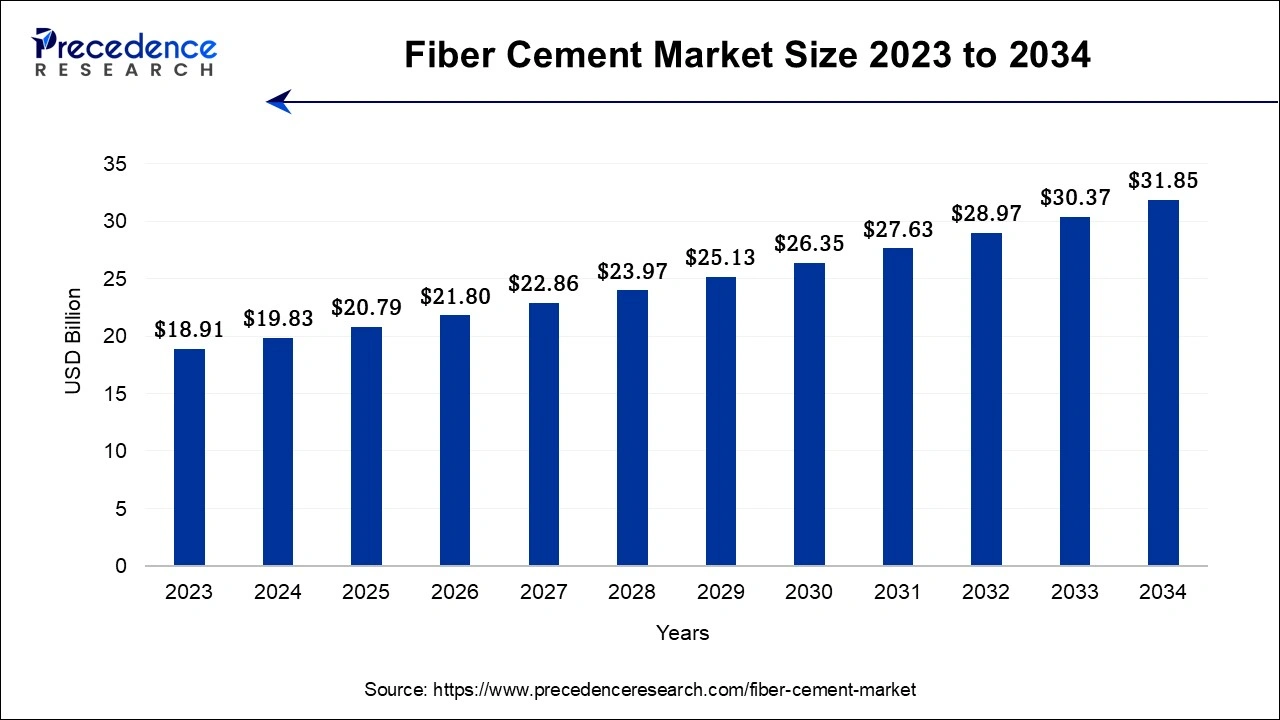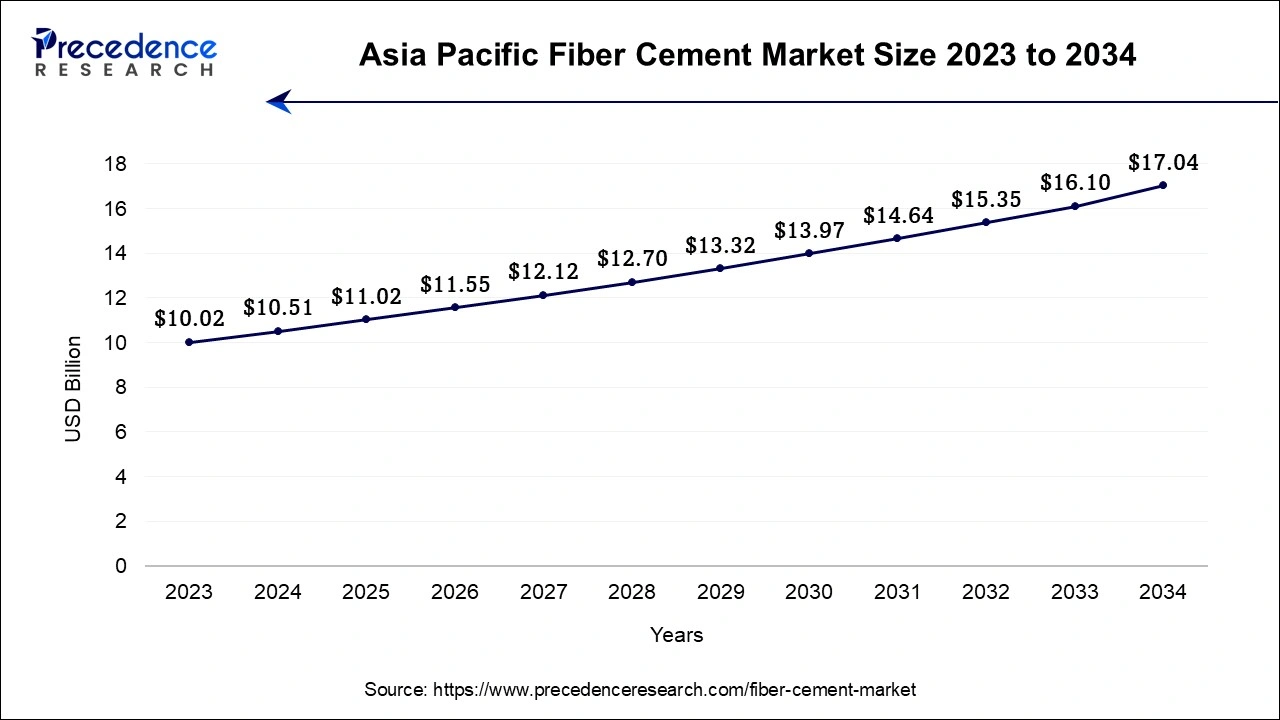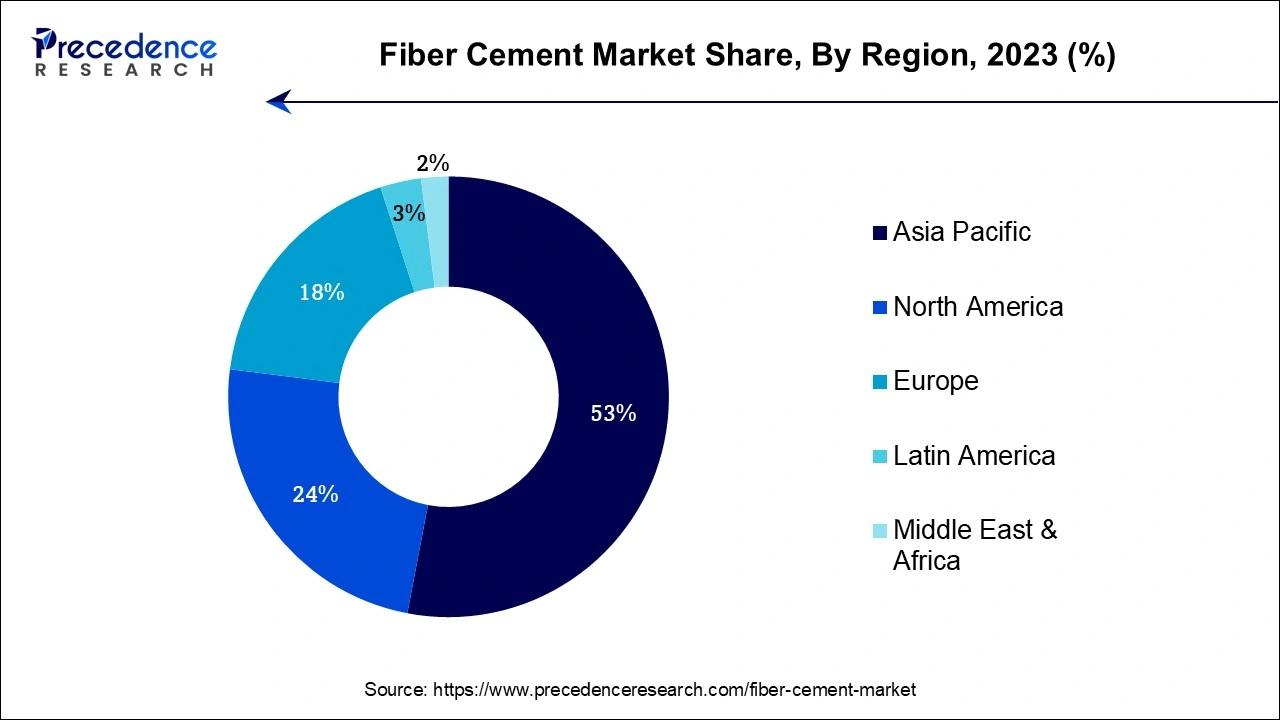April 2025
The global fiber cement market size is estimated at USD 19.83 billion in 2024, grew to USD 20.79 billion in 2025 and is predicted to hit around USD 31.85 billion by 2034, expanding at a CAGR of 4.85% between 2024 and 2034.
The global fiber cement market size accounted for USD 19.83 billion in 2024 and is anticipated to reach around USD 31.85 billion by 2034, growing at a CAGR of 4.85% from 2024 and 2034.

The Asia Pacific fiber cement market size is estimated at USD 10.51 billion in 2024 and is predicted to be worth around USD 17.04 billion by 2034, at a CAGR of 4.95% from 2024 and 2034.

Asia Pacific dominated the market with the largest market size in 2022, the region is expected to maintain its position throughout the forecast period. The growth of the market in this region is attributed to the rising population and the disposable income which tends to a significant growth in the real estate industry. The growing construction industry in commercial and non-commercial buildings results in the growth of the market in this region. The growing economies of the countries in the regions result in higher growth in industrialization and these contributed to the growth of the market across the region. In addition, the availability of raw materials, low-labor costs and potential players in the region drive the growth of the market.

North America is expected to witness significant growth in the market during the forecast period. Increasing industrialization and commercialization in the region will result in the growth of the market across the region. Moreover, substantial government support for the development of the construction industry in the region is observed to support the growth of the market.
Fiber cement is another advanced version of cement material, which is augmented by fiber material to make cement more effective and stronger. Fiber cement can be used in the development of strong and long-lasting construction materials. In recent times fiber cement is specialized and prominently used as cladding and roofing material. The commercial value, performance, and functional properties of fiber cement are observed to sustain its importance in the construction industry for the upcoming years.
Fiber cement requires low maintenance and is durable, the long-lasting property of fiber cement also acts as a significant factor for the application of fiber cement. There are some of the other significant properties of fiber cement such as it is not combustible in nature, it is water resistant and resistant to water damage. Moreover, the material is UV resistant and also resistive to wrapping and rotting. Such factors or properties contributed to the growth of the fiber cement market by highlighting its application for various end-users.
Fiber cement is being used in the various parts of the construction type, like the tiling backer board, or floor tiling base. Fiber cement tile backer board products are specially used in wet places such as bathrooms and kitchens due to its water resistance properties. The installation of the fiber cement backer board is very easy and can be directly installed on the stud wall. Rising construction activities across the globe along with rising requirement for sustainable material for construction activities across the globe acts as a growth factor for the market.
Fiber cement is also used as a cladding material and becomes the major alternative to wooden cladding, and PVC or vinyl. It is very durable and has lower maintenance as compared to the other cladding material. Fiber cement cladding is water-resistant and resistant to termites, woodpeckers, and other pests. The rising construction industry globally will enhance the growth of the fiber cement market in the upcoming period. The rising population and the economic development of the countries will tend to the rising commercialization in the world will result in the rise in the construction industry.
The increasing construction industry will result in a higher demand for durable and long-lasting materials for the stronger construction of the building. Various functional properties of fiber cement contributed to the growth of the fiber cement market. The adaptation of fiber cement in residential, non-residential, infrastructural, hospitality, etc. the growth of the residential segment highly contributed to the growth of the fiber cement market.
| Report Coverage | Details |
| Market Size in 2024 | USD 19.83 Billion |
| Market Size by 2034 | USD 31.85 Billion |
| Growth Rate from 2024 to 2034 | CAGR of 4.85% |
| Largest Market | Asia Pacific |
| Base Year | 2023 |
| Forecast Period | 2024 To 2034 |
| Segments Covered | Raw Materials, Raw Materials, End User, and Region |
| Regions Covered | North America, Europe, Asia-Pacific, Latin America, and Middle East & Africa |
Aesthetic looks for construction
Homebuilders are focused on installing these adaptable panels in a variety of forms using fiber cement, which is utilized in homes all over the world. Fiber cement in combination with other products and materials can be successfully used to give texture and aesthetic interest to façade. Using various finishes and veneers provides home design with a dynamic appearance, whereas combining textures is considered to be an ideal way to add contrast to façade. As the demand for aesthetic appearance for construction increases, the market is observed to be accelerated.
Environmental concerns in production
The production of fiber cement generates waste such as fly ash, cement kiln dust and other by-products that require proper disposal. Improper waste management can lead to soil and water contamination. Cement production and curing process requires significant water usage, which can strain local water resources and contribute to water scarcity issues. Thus, potential environmental issues caused during the production of cement acts as a restraint for the market.
Utilization of fiber cement sheets
A roof is an important part of a house that is intended to remain for decades, if not forever. Aside from being a functional home covering, a roof is also the first thing people notice from a distance. As a result, they must be visually appealing. Keeping this in mind, a fiber cement sheet emerges as a possible roofing solution. Fiber cement sheets are becoming increasingly popular among architects for a variety of reasons, including their ability to withstand weather changes even as they age. The components used to make fiber cement sheets are resistant to moisture, making it an appropriate roofing material for wet areas, one significant advantage of fiber cement over concrete tiles is that it is substantially lighter in weight. Moreover, the aesthetic look offered by fiber cement sheet is another factor for using such sheets in construction. Thus, the rising utilization of fiber cement sheets is observed to act as an opportunity for the market.
The Portland cement segment dominated the market with the highest share in 2022, the segment is expected to continue the trend in the upcoming period. Portland cement is widely being used in the manufacturing of buildings, bridges, dams, and pavements, etc. It is also used as plastering material, filler material, and floor surface smooth material. It is used for the smoothening of the surface of the floor. Portland cement minimizes pollution to the environment, so it will be beneficial for the manufacturers as well as consumers seeking a sustainable choice. It is cost-effective, so the construction cost of the building can be minimized due to the lower cost of cement. Portland cement carries crack-resisting property, it reduces the risk of cracking in buildings. All these factors highly contribute to the growth of the segment.
The siding segment dominated the market with a higher market share in 2022. The growth of the segment is attributed to the increasing use of siding fiber cement for the increasing exterior look of the building. Fiber cement siding is the lower maintenance exterior of residential and non-residential buildings. Siding protects and helps to maintain the building from the exterior elements. Siding is a major application or type of fiber cement in both the residential and non-residential sectors.
Fiber cement siding is cost-effective and is generally made of wood pulp or fiber, fly ash, sand, clay, and Portland cement. The siding is durable, has fire resistance, and has pest protection. These properties contribute to the growth of the segment in the fiber cement market.
The residential segment dominated the market with the highest market share in 2022. The growth of the segment is attributed to the rising use of fiber cement in the retrofitting of houses. The rising construction activities, especially in developing countries, promote the segment’s growth. The requirement for durable and low-maintenance material for residential construction plays a significant role for the segment’s growth.
On the other hand, the non-residential segment is observed to witness a significant growth during the forecast period. Fiber cement is generally used in commercial buildings like mills, factories, warehouses, etc. Nonresidential includes industrial, commercial, and agricultural buildings. The supporting regulations by the government bodies of the countries such as The United States, Canada, United Kingdom, etc. Is expected to boost the construction program in non-residential projects. Rising economic growth tends to the rise in the development in the construction industry which results in the growth of the segment.
Segments Covered in the Report:
By Raw Materials
By Construction Type
By End User
By Geography
For inquiries regarding discounts, bulk purchases, or customization requests, please contact us at sales@precedenceresearch.com
No cookie-cutter, only authentic analysis – take the 1st step to become a Precedence Research client
April 2025
September 2024
September 2024
January 2025